Anodizing Finishing Services
AT-Machining offers premium anodizing services to enhance durability and aesthetics of aluminum components. Our advanced techniques ensure precision finishing that meets diverse project needs.

Anodizing Overview and Advantages
Anodizing electrolytically creates a durable oxide layer on aluminum for superior protection and aesthetics.
By passing an electric current through an electrolytic bath, a tough oxide layer forms that resists wear and corrosion while accepting color dyes for vibrant, long-lasting finishes.
The resulting anodized surface offers enhanced durability, insulation, and visual appeal. This makes anodizing a popular technique to extend product life, improve performance, and achieve a polished look across industries.
Enhanced Durability
Anodizing creates a thick oxide layer on the aluminum surface. This layer, being much harder than the aluminum itself, offers enhanced protection against chipping, peeling, and scratching, ensuring the component's longevity.
Corrosion Resistance
The protective oxide layer formed during the anodizing process acts as a barrier against environmental factors such as moisture, salts, or other corrosive agents. This protection ensures that aluminum parts remain unaffected by rust or corrosion, especially in challenging conditions.
Improved Aesthetics
Anodized aluminum surfaces can be dyed in a variety of colors. This flexibility in design choices, coupled with a rich metallic sheen, often results in a more attractive appearance than untreated or painted surfaces.
Electrical Insulation
The oxide layer that results from anodizing acts as an insulator. This insulation property can be crucial in electronic applications where specific components must be electrically non-conductive to function correctly.
Thermal Resistance
Certain types of anodizing can enhance the aluminum's thermal insulation properties, making it ideal for applications where heat retention or dissipation is a factor.
Improved Lubrication
Certain types of anodizing, like Teflon-impregnated hardcoat anodizing, can improve the lubrication properties of aluminum parts, reducing friction in moving components.
Types of Anodizing Offered by AT-Machining

Anodizing type II (Matte)
Anodizing Type II, often referred to as “Matte,” is a sulfuric acid anodizing process. It produces a uniform, oxide layer on aluminum, ensuring enhanced corrosion resistance and a non-reflective, matte finish. This method allows for diverse color dyeing options, providing both protection and aesthetics.
Anodizing Type II film thickness is 8-12 μm (clear) or 12-16 μm (black/color).
Color | Clear, black, blue, red, gold or any RAL code or Pantone number |
Texture | Grit #120 |
Price | $$ |
Material | Aluminum |
Noted: The dimensional accuracy achieved with various surface preparations is maintained after the anodizing process.

Anodizing type II (Glossy)
Anodizing Type II (Glossy) is a variant of the standard sulfuric acid anodizing process. It imparts a thicker oxide layer on aluminum, ensuring robust protection. Its unique procedure results in a reflective, glossy finish, elevating the part’s aesthetic appeal while maintaining its enhanced durability.
Anodizing Type II film thickness is 8-12 μm (clear) or 12-16 μm. (black/color).
Color | Clear, black, blue, red, gold or any RAL code or Pantone number |
Texture | Grit #120 |
Price | $$ |
Material | Aluminum |

Anodized type III (Hardcoat)
Anodized Type III, known as “Hardcoat,” uses sulfuric acid to create a densely packed oxide layer on aluminum. This process results in enhanced wear resistance and electrical insulation. The thick, durable finish, often darker in hue, stands up to extreme environments and rigorous use.
Anodizing Type III film thickness is 25-50 μm.
Color | Nature, black or other colors |
Texture | Grit #120 |
Price | $$ |
Material | Aluminum |
Custom Color and Thickness Options
We offer a selection of standard anodized color finishes (see Color Options). For custom RAL or Pantone color matching, contact our team at [email protected] to discuss your project’s requirements.
Our standard anodized layer thicknesses conform to ISO 7599: ISO class AA10 for clear anodizing and ISO class AA15 for colored anodizing. Our experts can accommodate custom thicknesses if your application calls for alternative anodizing thickness standards. Reach out to [email protected] to request a quote for non-standard anodizing.
Color options for aluminum anodizing
Because aluminum alloys have inherent variances, the final color of anodized parts may differ slightly from the standard color shades shown below. The color range indicates the spectrum of hues that can be expected with colored anodizing. Minor variations in hue are normal due to the tolerances in alloy composition.

Black

Clear

Gray

Blue

Teal

Green

Red

Purple

Orange

Pink

Gold

Yellow
Custom anodized colors are available – Contact us for specialty matching.
Gallery of anodized parts manufactured by AT-Machining
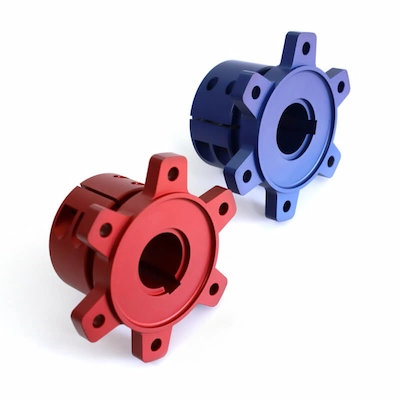


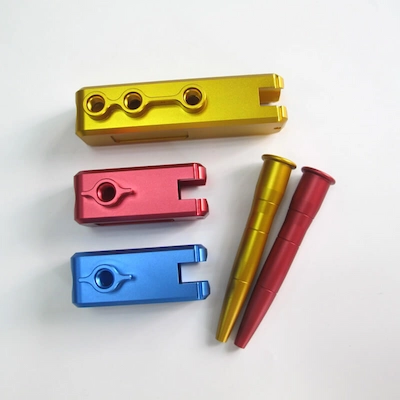
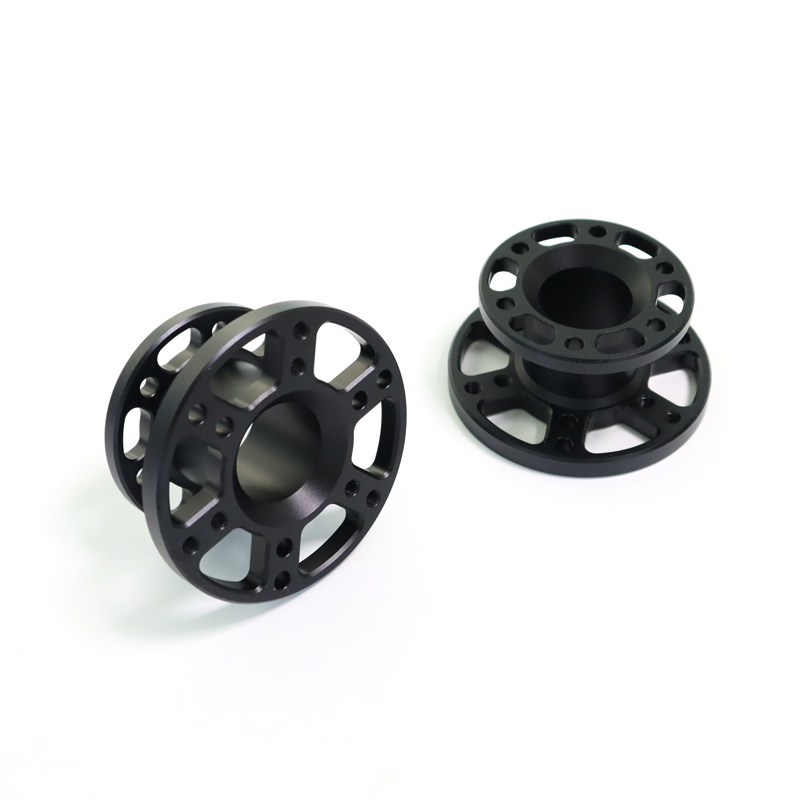
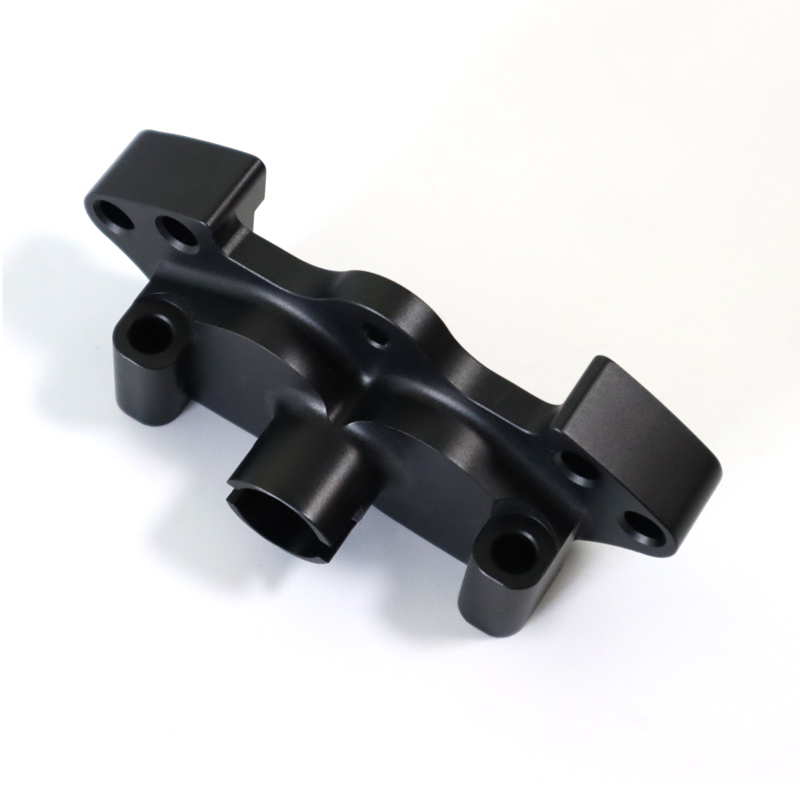
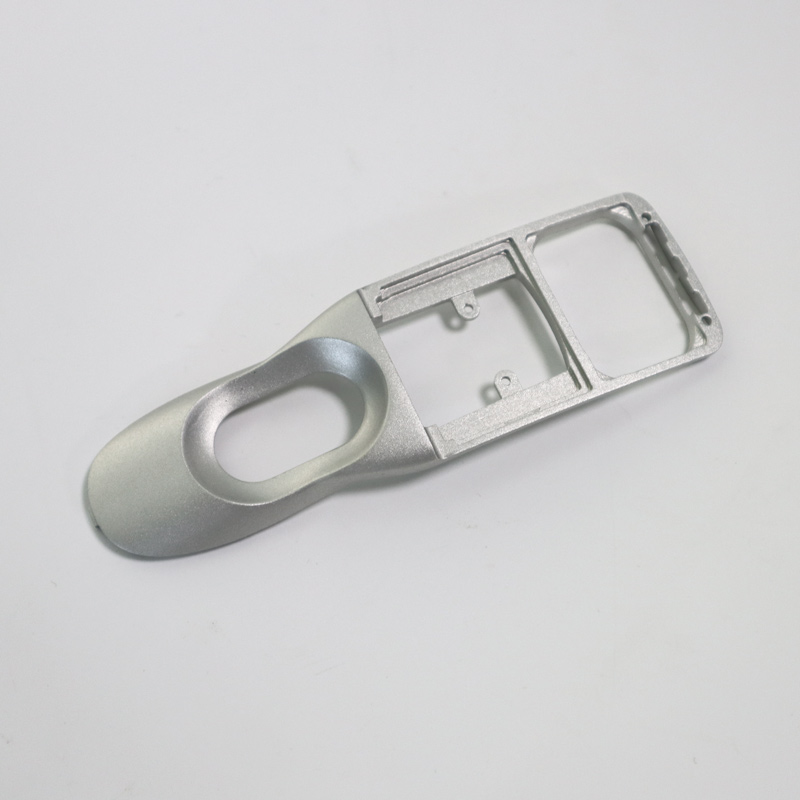
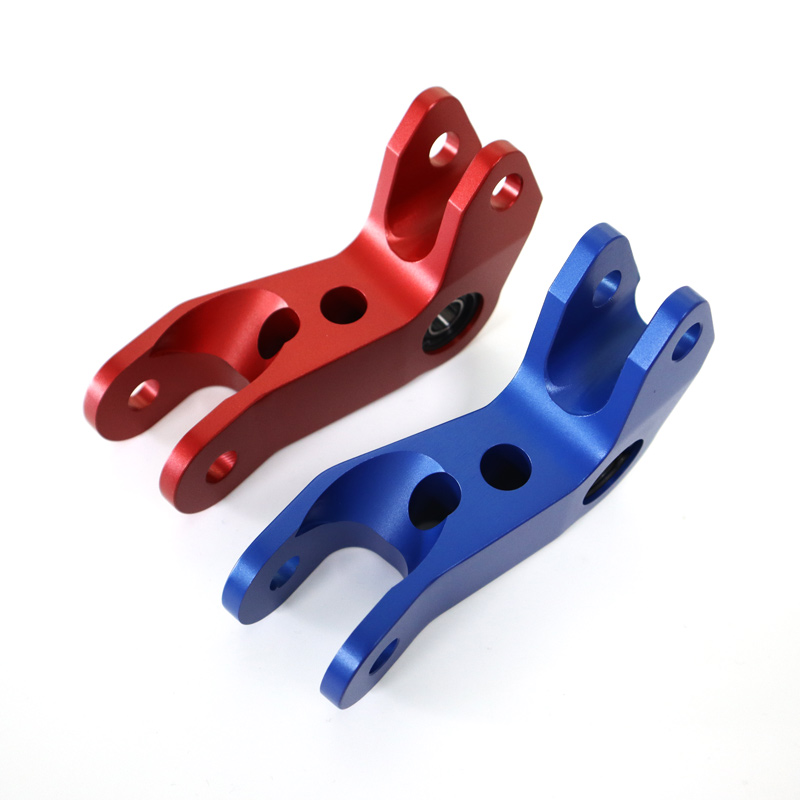
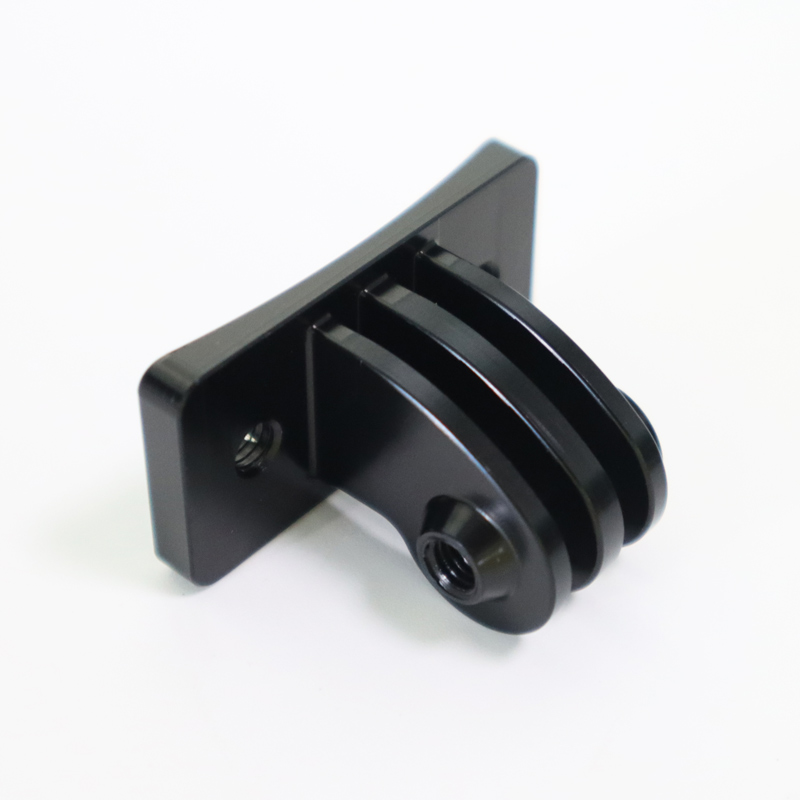
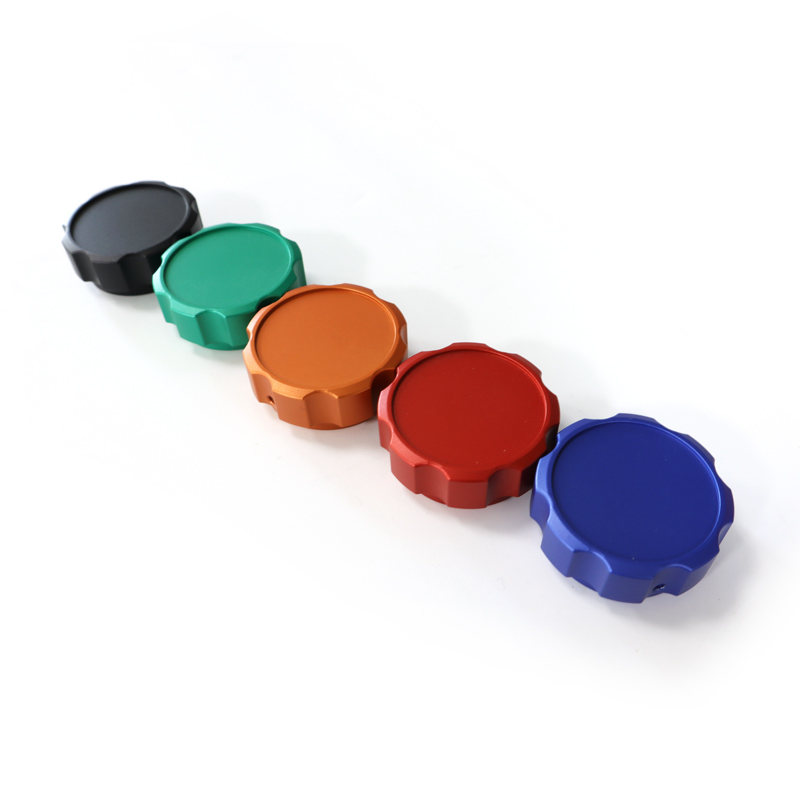
AT-Machining anodizing process
- Cleaning: Parts are cleaned in a non-etching, alkaline solution to remove surface impurities, ensuring a flawless anodizing result.
- Rinsing: Cleaned parts are thoroughly rinsed with deionized water to remove any remaining cleaning agent residues.
- Etching: Immersed in an acid bath (usually caustic soda), parts undergo etching to achieve a matte appearance or to prepare for further processing.
- Desmutting: This neutralizes and removes surface contaminants, ensuring a pure aluminum surface for the subsequent anodizing process.
- Anodizing: Parts are submerged in an electrolytic solution, typically sulfuric acid, and electrical current is passed to form the protective oxide layer.
- Coloring (optional): After anodizing, parts can be dyed by immersing them in a bath containing organic or inorganic colorants.
- Sealing: The anodized surface is sealed, typically in a hot water bath, to close pores, enhancing corrosion resistance and color retention.
Why Choose AT-Machining for your partner
Precision and Quality
AT-Machining employs state-of-the-art equipment and techniques, ensuring each anodized piece meets exacting standards for both functionality and aesthetics.
Expertise
With years in the industry, our team has honed its skills, offering unparalleled knowledge and proficiency in the anodizing process, guaranteeing optimal results.
Customization
Catering to client-specific needs, AT-Machining provides a range of finishes, from matte to glossy and even the robust Type III hardcoat, ensuring versatility in application and design.
Efficient Turnaround
Time is money. Recognizing this, we prioritize efficient workflows, ensuring timely project completion without compromising on quality.
Competitive Pricing
By optimizing our processes and leveraging long-standing industry relationships, AT-Machining offers competitive rates, giving clients top-tier anodizing solutions without breaking the bank.
Comprehensive Client Support
From initial consultations to post-service care, our dedicated team ensures clients are informed, supported, and satisfied every step of the way.
Other Finishing Services Available
Rust Our One-Stop Finishing Excellence
AT-Machining’s industry-leading expertise ensures unrivaled quality and convenience with our comprehensive, one-stop finishing services.
- Copper Plating
- Electroless Nickel
- Nickel Plating
- Nickel Sulfamate
- Tin Plating
- Zinc Plating
- Mechanical Polishing
- Electropolishing
- Vibratory Polishing
- Mirror Polishing
- Glass Bead Blasting
- Ceramic Bead Blasting
- Plastic Bead Blasting
- Steel Shot Blasting
- Stainless Steel Bead Blasting
Powder coating is a dry finishing process, using finely ground particles of pigment and resin electrostatically charged and sprayed onto surfaces. Cured under heat, it creates a durable, uniform, and attractive finish, popular for its environmental and performance benefits.
Black oxide, a conversion coating in surface finishing, chemically forms a protective black layer on metals, primarily ferrous alloys. It enhances corrosion resistance, reduces light reflection, and adds decorative appeal. Applied through hot or cold processes, the finish is often sealed with wax or oil to boost durability and protection.
Chromate conversion coating, often known as Alodine or Chemfilm, is a surface treatment for aluminum and its alloys. It forms a thin, protective chromate layer, enhancing corrosion resistance, promoting paint adhesion, and providing electrical conductivity. Commonly used in aerospace and automotive industries, it offers a decorative finish with minimal dimensional change.
DLC (Diamond-Like Carbon) coating is a nanocomposite finish that imparts a hard, wear-resistant surface to materials. Mimicking properties of natural diamond, it offers exceptional lubricity, corrosion resistance, and a reduced friction coefficient, making it ideal for automotive, tools, and precision components.
Brushing in surface finishing uses abrasive brushes to create fine, consistent lines on metal surfaces. This mechanical process enhances appearance, masks defects, and prepares surfaces for coatings. Offering various textures, from short to long grains, brushing ensures aesthetic refinement for various applications.
Titanium anodizing is a surface finishing process that modifies the oxide layer on titanium components. Enhancing corrosion resistance and biocompatibility, it also adds vibrant, interference-based colors without dyes or pigments. Popular in medical devices and aerospace, it combines aesthetics with functional benefits.
Passivation is a surface finishing process that treats stainless steel with a mild oxidant, removing iron contaminants and enhancing its natural oxide layer. This strengthens corrosion resistance and prevents unwanted reactions in environments like the medical, food, and aerospace industries.

